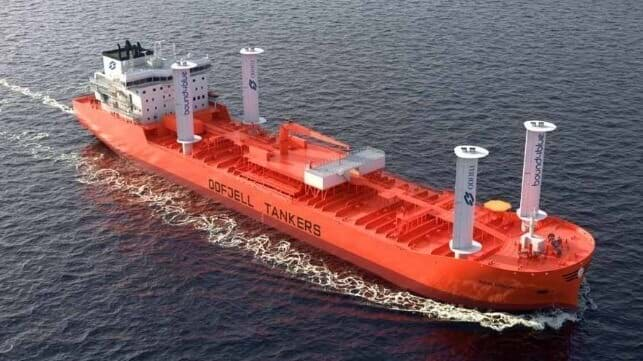Product tanker operator Odfjell looks to continue its efforts at reducing carbon emissions with the first test of a suction sail on a tanker. It comes as part of a larger overall effort that will also see the company start a test on air lubrication technology on another one of its vessels.
“Odfjell has installed more than 130 energy-saving devices on our vessels since 2014. In 1Q 2023, we reported a historically low carbon intensity – more than 50 percent below the IMO baseline for our fleet,” said Erik Hjortland, VP Technology for Odfjell discussing the company's efforts at reducing its emissions. “Our decarbonization efforts do not stop with this achievement – now is the time to start deploying more improved technologies.”
Bound4blue and Odfjell announced an agreement that will be the first test of the Spanish company’s suction sail technology aboard a tanker. The technology adds a component of suction to the sail which according to Bound4blue re-adheres the airflow to the sail, generating increased amounts of lift with low drag. A suction fan is incorporated into the structure which also has a rotation system and a flap at one side of the sail. Bound4blue states its eSail “produces six to seven times more lift than a conventional sail, with minimal power consumption and no mechanical complexity.” The sail is entirely automated and easy to install.
"We have been studying sail technologies as a potential energy efficiency measure for our fleet since 2020, and we are excited to now take the next step by partnering with Bound4blue to implement their eSail system on one of our chemical tankers," said Jan Opedal, Manager Projects at Odfjell. “This technology has significant potential to reduce emissions by harvesting the energy on the ship itself and transforming it directly into a forward thrust.”
The company told investors that it expects on average a nine percent fuel saving from the suction sail, with the installation scheduled for the first half of 2024. They noted that on routes with favorable wind conditions, there is a potential for significantly higher savings on fuel consumption which in turn reduces emissions. The selection of the wind-assisted propulsion system was made after an extensive study conducted by SSPA, evaluating the different technologies of Odfjell.
Details on the vessel to be used in the sail test were not announced and reportedly are still under discussion. Bound4blue hopes the pilot will also expand access for the air suction sail technology in the tanker sector.
This year, Odfjell also expects to begin a similar test on air lubrication which they expect could provide between six and eight percent reductions, to be verified in the pilot program. During the fourth quarter of 2023, the Alfa Laval OceanGlide system will be installed on the Bow Summer (45,592 dwt), a product tanker built in 2005. Odfjell expects to add three to five fluidic bands that generate air lubrication along the vessel’s flat bottom. Alfa Laval notes the technology provides for independent management of the bands for a more controlled and streamlined flow of air bubbles to ensure optimum efficiency, maximum coverage, and reduced compressor output.
The company said it decided to go forward with the two new novel technology projects with the aim to further improve fuel efficiency on its vessels. Odfjell currently has a fleet of 71 chemical tankers and notes its continuous improvement on its carbon intensity through fleet management and the use of new technologies.
BY THE MARITIME EXECUTIVE


